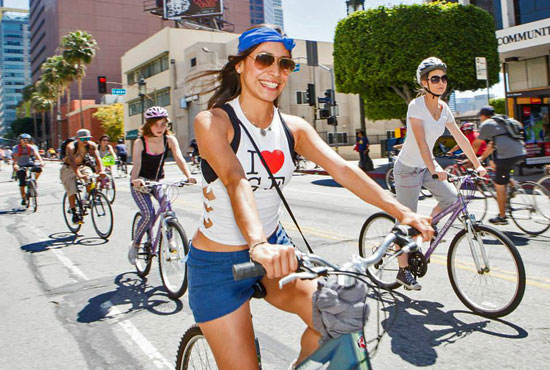New CicLAvias to hit the road
June 12, 2014
L.A. has tasted CicLAvia, and it wants more.
In early 2010, as preparations were being made for Los Angeles’ first car-free, open streets event, Santa Monica organizers were brainstorming doing the same thing in their city. While CicLAvia blasted off that October, quickly drawing crowds in excess of 100,000, Santa Monica’s plans never got rolling.
Cynthia Rose, director of the bike advocacy group Santa Monica Spoke, said that despite having an active cycling and walking community, her city simply didn’t have enough resources.
“We were not as far along and just did not have the money that CicLAvia had,” says Rose.
Enter Metro.
A year ago, the transportation agency launched a grant program to fund open streets events—closing streets so people can bike, walk and frolic freely—with the goal of spreading the CicLAvia love to more places. Nearly two dozen applications were received in April, and 12 were accepted in the first cycle of grants made public this week. Pending approval by Metro’s Board of Directors, the agency will spend $4 million during the next two years to bring 12 events to places like Santa Monica, Pasadena, Long Beach and the San Fernando Valley.
Rose says she’s excited that her city will now get a chance to put its unique mark on the rapidly-expanding open streets movement, which was initially inspired by mid-1970s ciclovias in Bogotá, Colombia. (“Ciclovia” translates roughly to “cycleway.”)
“This is something that the community is ripe for and really wants,” Rose says. “Ours is going to be more like a big street festival. It’s for everyone to share the street.”
The Santa Monica gathering is being planned for spring or summer of 2016, to take advantage of the excitement surrounding the opening of Expo Line Phase 2, which will extend the light-rail train from downtown L.A. to the coast. Rose hopes the event will highlight some of the investments that Santa Monica has made to improve bicycle and pedestrian infrastructure, including the Bike Center and L.A. County’s first-ever bike share program, which should be up and running in two years.
Still, a large chunk of the grant money is slated to go CicLAvia itself, with funding recommended for six major events that the organization is producing or co-producing. CicLAvia spokesman Robert Gard said the plan is to use the Metro money to reach new locations, including the San Fernando Valley, where an event is planned for spring of 2015.
“We’ve done nine events on this side of the hill and by the time we get to the Valley it will have been 11 events,” Gard said. “With all the people who come from the Valley and beyond to our events, it just makes sense.”
The proposed Valley route still must be tested and finalized, but planners envision it going through North Hollywood, Studio City and Sherman Oaks, along Ventura and Lankershim boulevards. Those streets are home to scores of shops and eateries, a thriving arts community, beautiful vistas of the Hollywood Hills and more. The route also would connect with Metro’s Red and Orange lines and several bike paths, making it easy to get there and back.
CicLAvia would like to make the San Fernando Valley a regular destination, Gard says. Future events could target other locations further west.
The Metro grants will also help smaller towns join the open-streets movement, with tens of thousands of dollars going to places like Carson, Downey and Lawndale for more modest-scale events.
“Anybody who hopes for public consciousness of bicycling hopes a ciclovia makes it into their community,” says Lars Clutterham of the Downey Bicycle Coalition. He says that, unlike Santa Monica, “Downey is in the early stages of investing in bicycle infrastructure—there is none.” Clutterham hopes that the prospect of open streets events will prompt investment in pedestrian and bicycle improvements.
Viviana Franco is the executive director of Lot to Spot, an organization behind the Lawndale Community Bicycle Ride and Open Street Event, another grant winner. She hopes Metro’s program is a tipping point for low income communities that have largely missed out on the events. Franco says that’s upsetting because people in these communities are already cycling and walking to get where they need to go, but are unable to take full advantage of the health and community-building that can come with those activities.
“CicLAvia is amazing,” Franco says. “Let’s bring it to other neighborhoods; let’s bring it to neighborhoods where diabetes and obesity are rampant.”
Under direction from its board, Metro has sharpened its focus in recent years on “active transportation,” including cycling and walking. The agency formed a Bicycle Roundtable to collaborate with the cycling community and it has invested millions in infrastructure, with more to come.
Diego Cardoso, Metro’s executive officer in charge of active transportation, says open streets events benefit all types of transportation in the county. Not only do they get people out of their cars, he says, they also get some folks to try public transit for the first time.
“They take transit because they are going to use a bike at CicLAvia, but then they learn the places it can take them.” That, Cardoso says, makes them more likely to take buses and trains in the future.
The proposed grant awards go to the Planning and Programming committee next Wednesday before reaching the full Board on June 26.
Posted 6/12/14














 405 bridge work causes a stink
405 bridge work causes a stink

